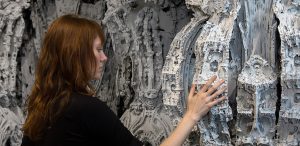The Digital Grotesque II
Digital Grotesque II – Grotto Fragments from Digital Grotesque on Vimeo.
Digital Grotesque II is a 3D printed grotto that was assembled in 2017, after about 2 years of designing and printing individual parts. The algorithmic architectural structure created by the architect Michael Hansmeyer is known for its intricate details and plethora of geometries that form the architecture. The project is a phenomenal piece that through its complexity captivates the viewer and bestows an unparalleled experience. The project is made of 7 tons of 3D printed sandstone. For its size, it is usual for such projects to be dull and rather lofty, but Digital Grotesque II defeats such a common notion with its details completely generated by computational design and algorithms.

From the most minute details to the whole form are entirely made through algorithms in the Digital Grotesque. Although the specific divisional ratios are not specified, the project was generated through subdivisions. As you can see in the video directly below, different division ratios allow for nearly infinite possibilities, hence the dynamic, mind-blowing design of the project. Although the algorithms are surely organized and planned, the endless variations bestow an element of “randomness”.
Hansmeyer’s computational architecture is deeply rooted in perspectives and perceptions. The specific, single divisional algorithm that he uses reflects these concentrations. The algorithm creates interesting, engaging topographies that are subject to interpretation by the users. The method itself does not involve randomness, but the output does, so the author of the project is anticipating the public to be able to physically experience his work and add their personal thoughts. This trend is also parallel to the continuity of Digital Grotesque II. Even the smallest details acknowledgeable and are part of the whole enclosure and form the experience of the project’s users.
The Digital Grotesque II definitely explores the potential in computational architecture and defies the notion that technology is not advanced enough to articulate intricate details. In fact, the specific project clearly shows how algorithms and 3D printing skills can actually produce details that traditional methods could not while maintaining quality and high resolution.
More information on the Digital Grotesque II can be found on its website:
Additionally, more information on Michael Hansmeyer’s computational architecture can be found on his website:
![[OLD FALL 2017] 15-104 • Introduction to Computing for Creative Practice](wp-content/uploads/2020/08/stop-banner.png)